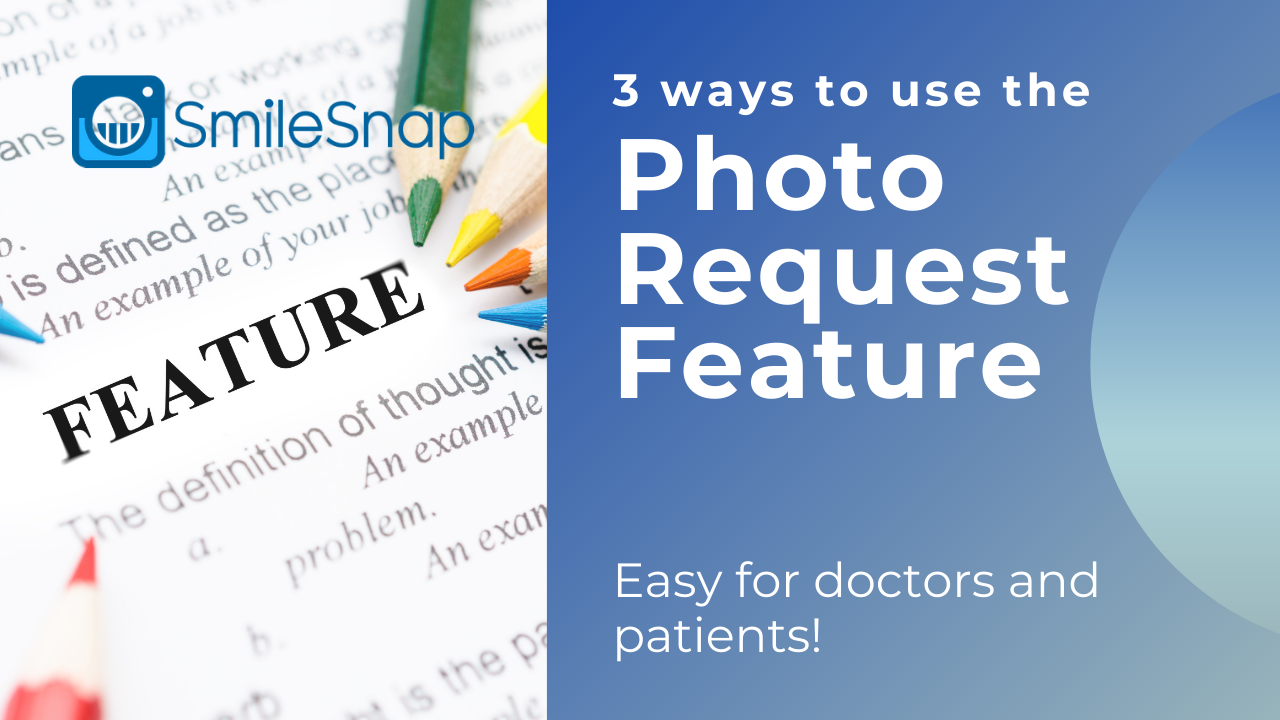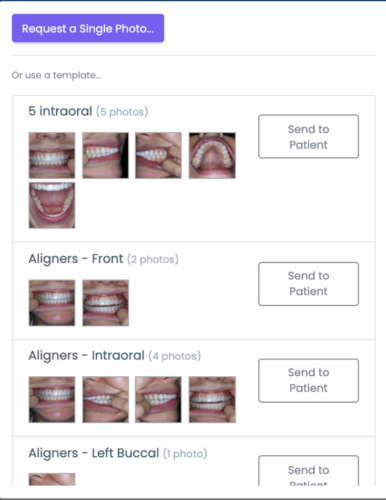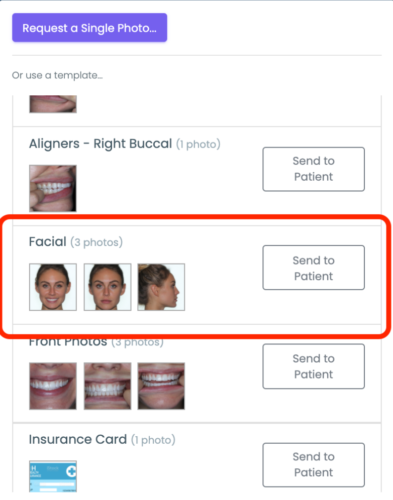3 Ways to Use our New Photo Request Feature

Virtual consultations are becoming the norm within the dental industry. With that growth, many patients seeking answers about treatment are jumping on board with the concept. Not only are new patient leads finding convenience in the concept, existing patients are able to utilize virtual services as well. We have created a feature that will assist in the accurate assessment for new patients, help you track the progress of treatment for existing patients, and evaluate when recall patients are ready to start treatment.
The Photo Request Feature will offer additional ease and convenience for you, your staff, and your patients. A few aspects that we love in regards to this feature are the automated emails that are sent to the patient prompting them to upload the photos in a guided, HIPAA compliant fashion, the fact you can receive additional photos outside of the 5 intraoral images, and the simplified ability to track patients that are in treatment or assess when ready for treatment.
There are a few different cases that we see this new feature helping you most!
No Photos Submitted
People are busy! With that said, there are going to be cases where a consumer lands on your website, gets excited that you offer virtual consultations, begins the process & registers, and then realizes it is not a convenient time to take their photos. Majority of the time, they will circle back and upload photos to their initial submission. This is something that can be done on their own time without you needing to request photos. However, since most people are busy, the request photos feature is an excellent way to push them along in the process and will act as a reminder that they need to finish up. We know if they land on your website and take the time to register that they are interested in finding out the information they need about starting treatment now. Quick responses and engagement is crucial in this stage so this feature will be a simple way to push them along in the process while their interest is at the highest.
We have preconfigured templates and one of those templates requests the 5 Intraoral photos that we have displayed on the widget. This would be the template we recommend using for submissions without photos. Don’t be afraid to use this feature within hours of receiving a consultation without photos, most patients will appreciate the reminder.

Need additional images to provide an accurate treatment plan.
The 5 intraoral photos will in most situations allow the doctor to determine the treatment plan; however, there may be situations where the doctor would benefit from additional photos. Our new feature supports the ability to request additional photos that differ from the 5 photos that they are guided to take on the widget.
One example would be for a case where a patient complained about the angulation of his or her teeth. For a case such as this, a side profile photo would be beneficial to see how the treatment result will look in comparison to the jaw line. Another example is a patient wanting to correct a “gummy” smile. The full facial smiling photo will allow the doctor to view the patient’s concern in relation to the full face. This will be super helpful to evaluate if treatment will make a difference or if perhaps maybe an additional specialist(s) will be needed for full correction.
For cases such as described above, we recommend using our preconfigured templates labeled ‘Facial’. This will prompt the patient to upload 3 photos – full face frontal images and a side profile. If you only need one image and don’t see it within our templates, it might make the most sense to use the ‘Request a Single Photo…’ button and add the single photo information to request just the one.

Existing Patient Check Ins
The request photos feature is an extremely convenient way to check in with existing patients and offers a level of convenience that they desire while freeing up chair time for you.
We have configured the best ways to utilize this feature for those patients who you are already working with.
OBS/Recall
Is the patient ready to start? Instead of them coming in the office, prompt them to upload photos where you can then evaluate the dental development. This is a fantastic way to track growth and better anticipate when the patient will be ready to start. Request the photos you need and track at multiple time points such as every 6-8 months. The patient and parents/guardians will love the option of having a quick check in without needing to schedule an in-office appointment. Your team will love this option because time will not be wasted reviewing cases of patients that aren’t ready to start yet.
We recommend sending your obs/recall patients our 5 intraoral photos template as well as our facial photos template to evaluate jaw growth.
Aligner Patients
If no clinical treatment is needed, Request Photos from your aligner patients to evaluate their progress. The photos will help you to determine if the patient is tracking well. Based on the photos, you will be able to tell if it’s okay to send your patient additional aligners or if early refinement is needed. If a patient appears to be getting off track but would benefit from more time in an aligner, save the patient a trip from coming in, and Request Photos for a quick check.
We recommend using our templates with the word ‘Aligner’ as these were designed to cater to patients currently in Aligner treatment.
Elastics
Keep a closer eye on the bite with elastic wear to prevent overcorrection. The Photo Request feature will keep your patient on track to completing treatment as planned when you can monitor the bite with more frequent photos.The multiple time points will allow you to make recommendations regarding any changes or continuation of elastic wear.
We recommend using our 5 intraoral photos template for patients that fall into this category.
Sign Up for SmileSnap Today!
Register for Smilesnap Now!


